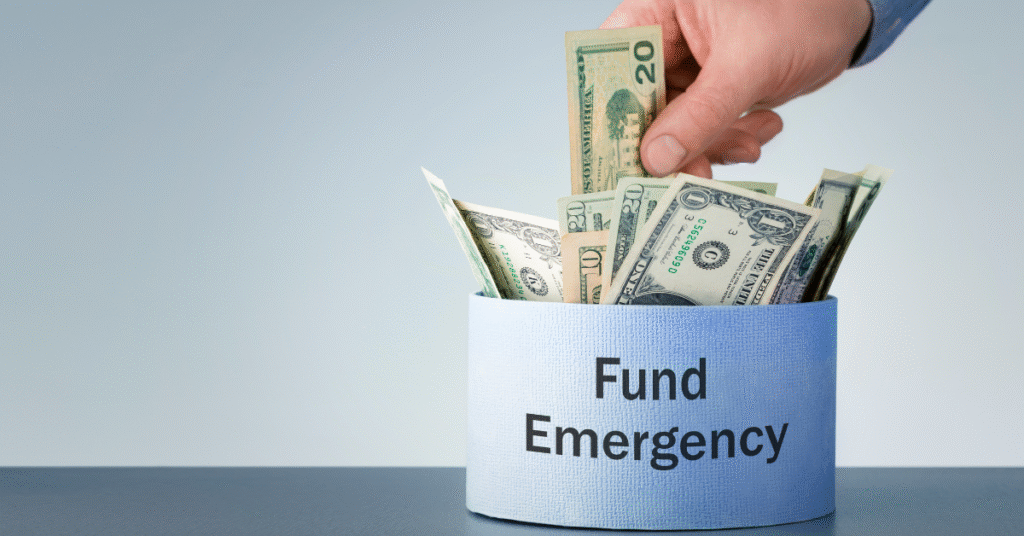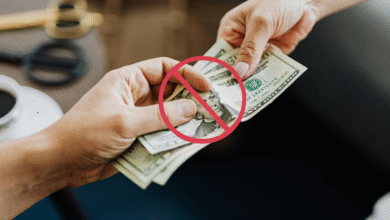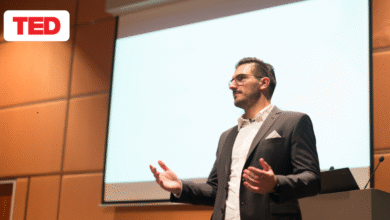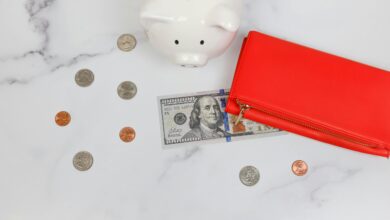How To Build An Emergency Fund In 7 Simple Steps

Look, I’m not going to sugarcoat this, life has a habit of throwing curveballs when you’re least prepared. Your car decides to break down the same week your laptop dies, or maybe your dog eats something weird and racks up a $800 vet bill. Fun times, right? :/
Here’s the thing: most Americans don’t have enough savings to cover a $400 emergency without going into debt. That’s not a judgment, it’s just reality. I’ve been there myself, staring at an unexpected expense and feeling that pit in my stomach.
Three years ago, my basement flooded during a freak rainstorm. Water everywhere. The repair bill? Just over $3,200. But here’s the plot twist, I didn’t panic. Why? Because I’d finally gotten serious about building my emergency fund. That moment validated every dollar I’d tucked away.
Today, I’m walking you through exactly how to build your own financial safety net. No complicated jargon, no unrealistic expectations, just seven practical steps that actually work in the real world.
What Is An Emergency Fund?
Think of an emergency fund as your financial fire extinguisher. You don’t want to use it, you hope you never need it, but you’re incredibly grateful it’s there when things go sideways.
An emergency fund is cash you set aside specifically for unexpected expenses, the stuff you can’t predict or plan for in your regular budget. We’re talking genuine emergencies here:
- Medical bills from sudden illness or injury
- Major car repairs that aren’t optional
- Urgent home repairs (like that leaking roof or broken furnace)
- Job loss or unexpected reduction in income
- Emergency travel for family situations
Notice what’s NOT on that list? A flash sale at your favorite store. Concert tickets. That “limited edition” gadget you suddenly need. Those are wants disguised as emergencies, and trust me, your future self will thank you for knowing the difference.
The beauty of having this fund is simple: when life gets messy, you’ve got options. You’re not forced to choose between putting expenses on a high-interest credit card or asking family for money. You handle it, move on, and rebuild your fund for next time.
I remember chatting with a colleague who lost his job unexpectedly. He had six months of expenses saved up. While getting laid off sucked, he told me he could actually sleep at night because he wasn’t immediately scrambling for survival. That’s the peace of mind we’re building here.
How Much Money Should Be In An Emergency Fund?
Alright, here’s where people get overwhelmed. Financial gurus throw around numbers like “$10,000!” or “Six months of expenses!” and suddenly building an emergency fund feels impossible.
Let me break this down based on actual financial planning principles and, honestly, common sense.
Starting Point: The $1,000 Foundation
If you’re starting from zero, your first goal is $1,000. That’s it. Not $10,000, not six months of expenses, just one thousand bucks. This baseline covers most common emergencies without being so overwhelming that you quit before you start.
Think about it: $1,000 handles a minor car repair, an urgent dental visit, or a broken appliance. It won’t cover everything, but it stops you from reaching for a credit card immediately.
The Standard Goal: 3-6 Months of Expenses
Once you’ve hit that $1,000 milestone, work toward the gold standard: three to six months of your essential expenses. Notice I said essential expenses, not your entire income.
- Calculate your bare-bones monthly costs:
- Rent or mortgage
- Utilities
- Groceries
- Transportation
- Insurance
- Minimum debt payments
If those essentials total $3,000 monthly, you’re aiming for $9,000-$18,000 in your emergency fund. Sounds like a lot? It is. But you’re not building this overnight.
- When You Need More (Or Less)
- Your target shifts based on your situation:
- Aim for 6-9 months if you:
- Work in a volatile industry with frequent layoffs
- Are self-employed or have irregular income
- Are the sole income earner in your household
- Have dependents or ongoing medical expenses
- You might get away with 3 months if you:
- Have dual incomes in your household
- Work in a stable industry with high job security
- Have excellent disability insurance
- Can easily move in with family temporarily if needed
IMO, most people should target six months. Three months disappears faster than you think during a real crisis.
Benefits Of Building An Emergency Fund
Let’s talk about why this matters beyond the obvious “you need money for emergencies” angle. The benefits run deeper than you might realize.
You Avoid the Debt Spiral
This is huge. Every dollar in your emergency fund is a dollar you don’t have to borrow. Credit cards charge an average of 20-25% APR right now. If you charge a $2,000 emergency and take a year to pay it off, you’re paying an extra $300-400 in interest.
Now multiply that by multiple emergencies. I’ve watched friends get trapped in this cycle, they use their card for one emergency, then can’t fully pay it off before the next emergency hits. Suddenly they’re drowning.
Your Stress Levels Drop Dramatically
I’m serious about this one. Research shows that financial stress affects your physical health, relationships, and job performance. When you know you’ve got a cushion, you sleep better. You’re not lying awake at 2 AM running worst-case scenarios.
There’s this psychological concept called “decision fatigue.” When you’re constantly stressed about money, you make worse decisions in every area of life. An emergency fund removes one massive source of that stress.
You Protect Your Long-Term Goals
Here’s what happens without an emergency fund: something breaks, you raid your retirement account or stop contributing to your 401(k). You cash out investments at the worst possible time or abandon your savings goals.
Your emergency fund acts as a protective barrier around your long-term financial plans. That investment portfolio? It stays invested. That retirement account? It keeps growing. You handle the emergency from your emergency fund like an adult, then move on.
You Gain Negotiating Power
This benefit flies under the radar, but it’s powerful. When you’re not desperate, you make better decisions. Car mechanic quotes you $1,200. You can get a second opinion instead of just saying yes out of panic.
Need to find a new job? You can actually be selective rather than grabbing the first offer. Landlord won’t fix something. You’ve got options. Financial security translates directly into real-world leverage.
How To Build An Emergency Fund In 7 Steps
Okay, enough theory. Let’s get into the actual process. These seven steps will take you from zero to fully funded, even if you think you can’t possibly save right now.

1. Create A Separate Emergency Savings Account
First things first: your emergency fund needs its own home. Keeping it in your checking account is like storing ice cream in a warm kitchen it’s going to disappear.
Open a dedicated savings account specifically for emergencies. Here’s what to look for:
High-yield savings account features:
- No monthly maintenance fees
- No minimum balance requirements (or very low ones)
- Competitive APY (aim for 4-5% in today’s market)
- Easy electronic transfers
- FDIC insured
I personally use Ally Bank and Marcus by Goldman Sachs for high-yield savings. Both consistently offer strong interest rates with zero fees. Capital One 360 is another solid choice.
Some people ask: “Why not just use my regular savings account?” Here’s why that’s a bad idea when the money sits with your other funds, you’ll convince yourself that buying those concert tickets is an “emergency.” Trust me, I’ve done it.
Pro tip: Open this account at a completely different bank from your checking account. This creates a tiny barrier just enough friction that you won’t casually transfer money out for non-emergencies. It should take a day or two for transfers to clear, which is perfect.
You want your emergency fund to be accessible but not too accessible. Not locked in a CD where you can’t touch it, but not sitting in your checking account where it’ll burn a hole in your pocket either.
The Interest Rate Reality Check
Yes, you should maximize your interest rate free money is free money. But don’t let this become your main focus. You’re not building this fund to get rich from interest. You’re building it for security.
If your high-yield savings account earns 4.5% APY on $10,000, that’s $450 annually. Nice bonus, but the real value is having that $10,000 when your transmission fails.
2. Automate Deposits Into Your Savings Account
Here’s where most people fail: they plan to manually transfer money “whenever they have extra.” Spoiler alert you’ll never have extra. There’s always something else to spend money on.
The solution? Automation. Make saving for emergencies automatic, non-negotiable, and invisible.
Set up automatic transfers from your checking account to your emergency savings account. This happens immediately after your paycheck hits before you can spend the money on anything else.
Here’s how to make this work:
If you’re paid biweekly (26 paychecks per year):
- Figure out your monthly savings goal
- Divide by 2
- Auto-transfer that amount the day after each paycheck
If you’re paid monthly:
- Transfer your savings goal amount on the first of each month
- Or split it into weekly transfers to make it less noticeable
I recommend starting with just 5% of your take-home pay. Doesn’t sound like much? On a $3,000 monthly income, that’s $150/month or $1,800 per year. You’ll hit that initial $1,000 goal in under seven months.
Can’t swing 5%? Start with 3%. Or even 2%. The specific percentage matters way less than building the habit.
Treat It Like a Bill
This is the mindset shift that changed everything for me: I started treating my emergency fund contribution like my rent or electric bill something that HAD to be paid every month.
Would you skip paying your electricity because you wanted to grab drinks with friends? No. Apply that same non-negotiable thinking to your savings.
Most banks and credit unions make automation dead simple:
- Log into your online banking
- Look for “Transfers” or “Payments”
- Set up a recurring transfer
- Choose the amount, frequency, and date
Done. Takes five minutes to set up, runs automatically forever.
FYI, many employers also let you split your direct deposit between multiple accounts. You can have $150 go straight to emergency savings and the rest to checking. Even better—you never see that money in your checking account, so you don’t miss it.
3. Break Down Your Savings Goal Into Smaller Steps
Looking at a $15,000 emergency fund goal when you’ve got $0 feels impossible. It’s like standing at the bottom of Mount Everest in flip-flops overwhelming and kind of ridiculous.
The secret? Chunk it down.
Instead of obsessing over that massive final number, focus on tiny, achievable milestones. This keeps you motivated and prevents burnout.
The Mini-Milestone Strategy
Your first mini-goal: $500
This should take just a few months if you’re saving even $50-100 monthly. It’s small enough to feel achievable but big enough to matter. $500 covers lots of minor emergencies a car repair, a minor medical bill, an unexpected expense.
When you hit this, celebrate. Seriously. You’ve officially started your emergency fund. Most people never make it this far.
Second mini-goal: $1,000
This is your foundation. Once you’ve got a grand saved, you’ve got legitimate protection against common emergencies. This milestone deserves a bigger celebration (free celebration don’t spend your emergency fund celebrating).
Third mini-goal: One month of essential expenses
Calculate your bare-minimum monthly costs. This milestone means you could survive a month without income. That’s powerful.
Fourth mini-goal: Three months of expenses
You’re in the game now. Three months of expenses gives you real security. Job loss doesn’t immediately equal crisis mode.
Final goal: Six months of expenses
Welcome to financial stability. You’ve built a legitimate safety net.
Why This Works Psychologically
Your brain loves checking things off. Small wins create momentum. Every milestone you hit releases a little dopamine hit that keeps you motivated.
I use a visual tracker just a simple chart on my fridge where I color in sections as I hit milestones. Sounds cheesy, but it works. You could also use savings apps with progress bars or just a spreadsheet.
The point is this: break your huge goal into bite-sized pieces that your brain can actually process. You wouldn’t try to eat an entire pizza in one bite, right? Same principle.

4. Funnel Extra Money Into Your Savings Account
Your automatic contributions are your baseline the steady drumbeat that builds your fund over time. But you can accelerate this process significantly by capturing “found money” and throwing it straight into savings.
Think of this as putting your emergency fund on fast-forward mode.
Where to Find Extra Money
Tax refunds: The average tax refund is around $3,000. Instead of treating this like free spending money, direct the bulk of it to your emergency fund. You can keep 10-20% for something fun, but the rest should go straight to savings.
Real talk getting a huge tax refund means you’re giving the government an interest-free loan all year. I’ve adjusted my W-4 to get smaller refunds and increased my automatic monthly transfers instead. But if you struggle with saving, that annual lump sum can be a powerful boost.
Work bonuses: Got a performance bonus? Holiday bonus? Commission check that’s bigger than usual? Before you start shopping, move at least 50% to your emergency fund.
I know the temptation to spend unexpected money is intense. Your brain screams “FREE MONEY!” But here’s the thing this IS money you earned. You just weren’t counting on it, which makes it perfect for savings.
Side hustle income: If you do freelance work, sell stuff online, or have any side income, consider directing 100% of it to your emergency fund until you hit your goal. Your regular paycheck covers your lifestyle; side money builds your security.
Gifts and windfalls: Birthday money from grandma? Inheritance? Settlement check? Again, these are perfect opportunities to massively boost your emergency fund.
Raises and promotions: This is sneaky good. When you get a raise, increase your automatic savings transfer by that same amount BEFORE you adjust your lifestyle upward.
Let’s say you get a 3% raise that works out to an extra $150 monthly. Immediately increase your automatic transfer by $150. You never adjust to having that money, so you don’t miss it, but your emergency fund grows dramatically faster.
The 48-Hour Rule
Here’s a mental trick that helps: when extra money hits your account, you have 48 hours to move it to savings. After that, it gets absorbed into your mental spending money and becomes “yours” to spend.
Move it quickly, move it automatically, and don’t overthink it.
5. Boost Your Income And Cut Expenses
Alright, let’s address the elephant in the room. Sometimes, building an emergency fund isn’t about better savings tactics it’s about math. If there’s simply nothing left at the end of the month, you need to work both sides of the equation.
Increase what comes in. Decrease what goes out.
The Expense-Cutting Side
I’m not going to tell you to skip your daily coffee. That advice is tired and condescending. Yes, $5 daily adds up to $1,825 annually, but life without small pleasures isn’t worth living.
Instead, focus on the big rocks the expenses that actually move the needle:
Housing: This is usually 25-35% of your budget. Can you:
- Get a roommate?
- Move to a cheaper place when your lease is up?
- Negotiate your rent?
- Rent out a parking space or storage area?
Cutting housing costs by even $200/month puts $2,400 annually toward your emergency fund.
Transportation: The average car payment is now over $700 monthly. That’s insane. Could you:
- Drive your paid-off car longer instead of upgrading?
- Refinance your car loan for a lower rate?
- Use public transportation more often?
- Sell your expensive car and buy something reliable but cheaper?
Subscriptions: Most people have 5-10 subscriptions they barely use. Go through your credit card statements. Cancel ruthlessly. You can always resubscribe later if you actually miss something.
Insurance: When did you last shop around for car and home insurance? Call three companies for quotes. Takes an hour, often saves $500+ annually.
Groceries: Meal planning and shopping with a list prevents impulse buys. I’ve cut my grocery bill by 30% just by planning meals and actually using the food I buy instead of ordering takeout when I’m too lazy to cook.
The Income-Boosting Side
Cutting expenses has a ceiling you can only cut so much. Income? That’s theoretically unlimited.
Negotiate your salary: Most people never ask for raises. If you’ve been at your job over a year and performing well, schedule a meeting. Research market rates, document your contributions, and ask for 10-15% more. Even if you get half that, it’s money you didn’t have before.
Freelance your skills: Whatever you do professionally, someone will pay for it on a freelance basis. Designer? Writer? Coder? Consultant? Accountant? Jump on Upwork or Fiverr.
Monetize your hobbies: Good at photography? Crafts? Pet sitting? Turn it into side income. Rover for pet care, Etsy for crafts, TaskRabbit for handyman work.
Gig economy opportunities: DoorDash, Uber, Instacart these aren’t glamorous, but they’re flexible. A few hours on weekends can generate an extra $400-600 monthly that goes straight to your emergency fund.
Sell your stuff: That’s right, Marie Kondo your life. We all have clothes we don’t wear, electronics we don’t use, and random stuff collecting dust. Facebook Marketplace, eBay, and local consignment shops turn your clutter into cash.
The combination of cutting your biggest expenses and adding even a small income stream can dramatically accelerate your emergency fund timeline. Cutting $200 in expenses plus earning $300 from side work equals $500 monthly that’s $6,000 annually toward your goal.
6. Review Your Budget
You can’t build an emergency fund in a vacuum. Your entire financial picture needs to support this goal, which means regularly examining where your money actually goes.
Most people have zero clue where their money disappears to. They earn a decent income but somehow end each month with nothing to show for it. The culprit? Untracked spending and budget drift.
Track Your Actual Spending
Before you can review your budget, you need to know what you’re actually spending. For one month, track every single dollar. Every coffee, every app purchase, every impulse buy.
Use apps like:
- YNAB (You Need A Budget)
- Mint
- PocketGuard
- Or just a simple spreadsheet
Most people experience genuine shock when they see their spending laid out. “$400 on restaurants?! $150 on random Amazon purchases?!”
That awareness is gold. You can’t fix what you don’t measure.
The Monthly Review Process
Set aside 30 minutes at the end of each month. Look at three things:
1. Spending vs. Budget Where did you overspend? Where did you underspend? Were your original estimates accurate?
If you budgeted $300 for groceries but consistently spend $450, you need to either adjust your budget or change your behavior. Pretending you’ll spend less than you actually do just sets you up for failure.
2. Emergency Fund Progress Did you hit your savings target this month? If not, what got in the way? Was it a legitimate unexpected expense (which proves you need the fund) or lifestyle creep?
3. Upcoming Expenses Look ahead to next month. Are there any known expenses coming up? Budget for those now so they don’t derail your emergency fund contributions.
Adjust and Optimize
Your budget isn’t static. Life changes. Prices increase. Your income fluctuates. Review and adjust regularly.
Maybe you discover you’re spending way too much on entertainment. Great, cut that by 25% and redirect those dollars to your emergency fund.
Or maybe you realize you’ve been unrealistic about your grocery budget, and underfunding it causes you to blow the budget every month. Fine, adjust the grocery line item up slightly and find the money by cutting somewhere less important.
The goal isn’t perfection. The goal is awareness and continuous improvement.
One huge tip: As your financial situation improves, you pay off a debt or your income increases, redirect that money to your emergency fund rather than inflating your lifestyle.
That paid-off car loan. Those $350 monthly payments can now go to savings. Your emergency fund hits its target way faster this way.
7. Use The Emergency Fund Only In An Emergency
This sounds obvious, but it’s where most people fail. They build up a decent emergency fund, then slowly drain it for things that absolutely aren’t emergencies.
Your emergency fund is not a vacation fund. It’s not a new TV fund. It’s not a “I really want this” fund.
It’s an emergency fund, and the key word there is EMERGENCY.
What Qualifies as an Emergency?
Use this simple test: Is this unexpected, necessary, and urgent?
Legitimate emergencies:
- Medical or dental emergency requiring immediate attention
- Car repair needed to get to work
- Essential home repairs (broken furnace in winter, major leak, etc.)
- Job loss requiring funds to cover basic expenses
- Emergency travel due to family crisis
NOT emergencies:
- That new iPhone that just came out
- Black Friday sales, even really good ones
- A vacation everyone’s going on
- Furniture or home upgrades you want
- Gifts and celebrations
The Gray Area
Some situations feel emergency-ish but aren’t quite clear-cut. Like, your laptop is dying slowly do you wait for complete failure or replace it now?
Here’s my framework: If you can plan for it, even with two weeks notice, it’s not an emergency. Your emergency fund is for things that slap you in the face with zero warning.
That slowly dying laptop? You’ve got time to save up specifically for its replacement in your regular budget. Set aside $50-100 monthly for a few months until you can buy a new one. This keeps your emergency fund intact for actual emergencies.
The Discipline Challenge
The hardest part isn’t building the fund it’s not touching it. Seriously. You’ll be tempted. There will be things you really want. Your brain will do Olympic-level mental gymnastics to convince you that buying concert tickets is somehow an emergency because “everyone is going and you’ll miss out.” Stay strong 🙂
Tricks to maintain discipline:
- Make it slightly difficult to access. That separate bank with 2-day transfer times? That’s by design.
- Set up rules. I require a 24-hour waiting period before touching emergency funds. If it’s still an emergency tomorrow, fine. Usually, the “emergency” feeling passes.
- Build sinking funds for planned expenses. Have a separate account for things like car maintenance, annual insurance premiums, holiday gifts stuff you know is coming. This prevents you from raiding your emergency fund for “emergencies” that aren’t really emergencies.
- Use the replacement rule. After using your emergency fund, immediately rebuild it. Make it your top financial priority until you’re back to your target amount.
I used my emergency fund once for a real emergency that basement flood I mentioned earlier. Dropping $3,200 hurt, but that’s what the fund was for. I immediately increased my monthly contributions from $250 to $400 until I rebuilt it fully. Took about nine months, but I did it.
Give Yourself Permission
Here’s the flip side: when a real emergency happens, USE THE FUND without guilt. That’s what it’s there for.
Some people build an emergency fund then feel weird about actually using it during emergencies. They put expenses on credit cards instead because spending the emergency fund feels wrong somehow.
That’s backwards. You built this specifically for emergencies. When they happen, draw from the fund confidently, handle the situation, then rebuild. That’s the cycle.
Final Thoughts On Building An Emergency Fund
Building an emergency fund isn’t exciting, but it’s one of the smartest financial moves you can make. It gives you freedom from panic, debt, and stress when life takes an unexpected turn.
Most people never start because they don’t make it a priority. You already know the steps: open a savings account, automate deposits, set small goals, and use it only for real emergencies.
Start now, stay consistent, and your future self will thank you for the peace and security it brings.
Now stop reading and go set up that account 🙂








